Team Development and Performance: Adidas Case Study Analysis Report
VerifiedAdded on 2022/08/09
|14
|3395
|25
Report
AI Summary
This report examines team development and performance, focusing on the characteristics of effective teams, methods of team development, and approaches to setting team objectives, monitoring, and evaluating team performance. The report utilizes the Adidas case study to illustrate these concepts. It analyzes the attributes of successful teams, such as communication, goal orientation, and effective leadership, drawing on models like Tuckman’s Five Stage Team Development Model and Rubin, Plovnick, and Fry's GRPI Model of Team Effectiveness. The report also explores various team development methods and motivational factors within Adidas. Furthermore, it discusses the process of setting team objectives, emphasizing the alignment of objectives with team member competencies and organizational goals. Finally, it addresses the importance of performance evaluation and monitoring to ensure teams meet expectations and achieve their objectives.
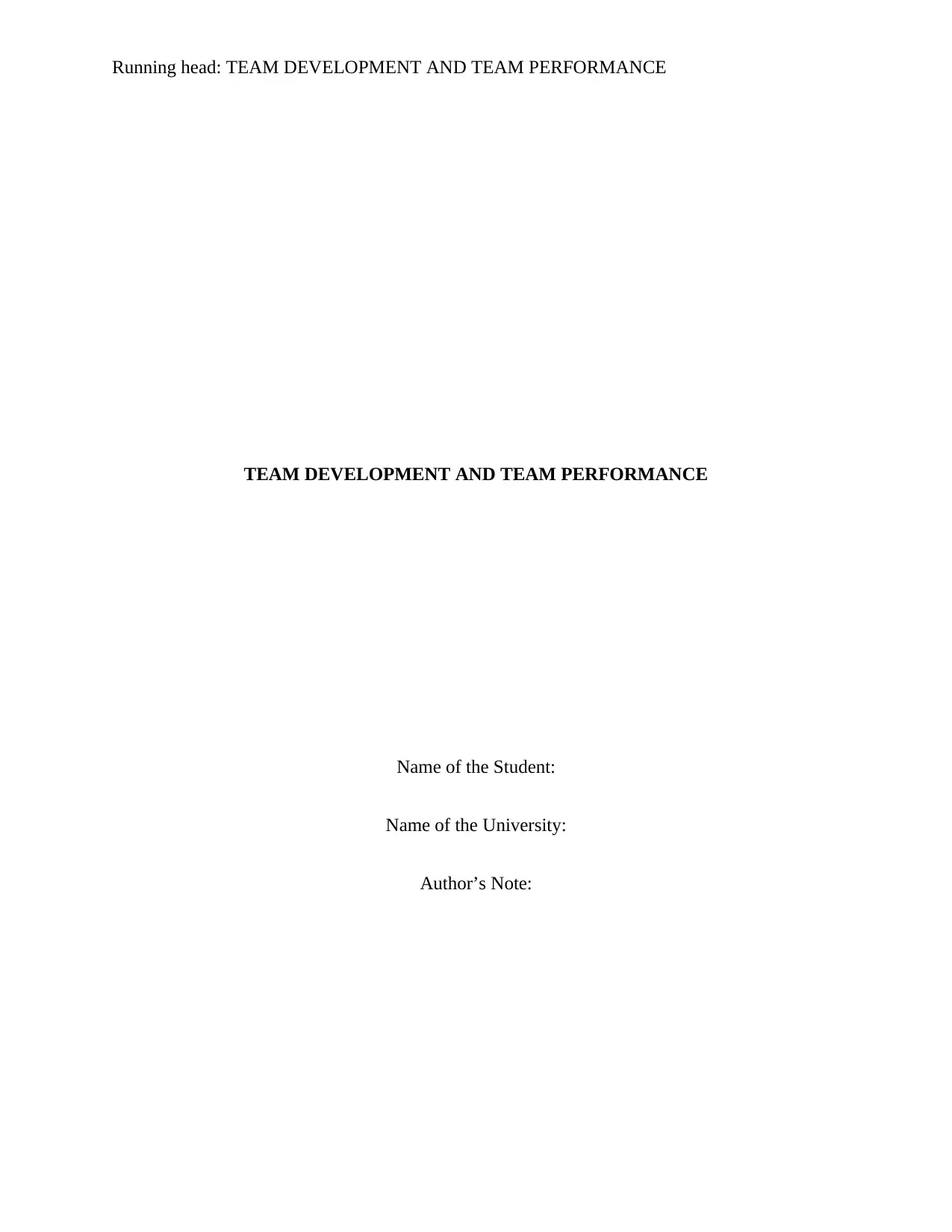
Running head: TEAM DEVELOPMENT AND TEAM PERFORMANCE
TEAM DEVELOPMENT AND TEAM PERFORMANCE
Name of the Student:
Name of the University:
Author’s Note:
TEAM DEVELOPMENT AND TEAM PERFORMANCE
Name of the Student:
Name of the University:
Author’s Note:
Paraphrase This Document
Need a fresh take? Get an instant paraphrase of this document with our AI Paraphraser
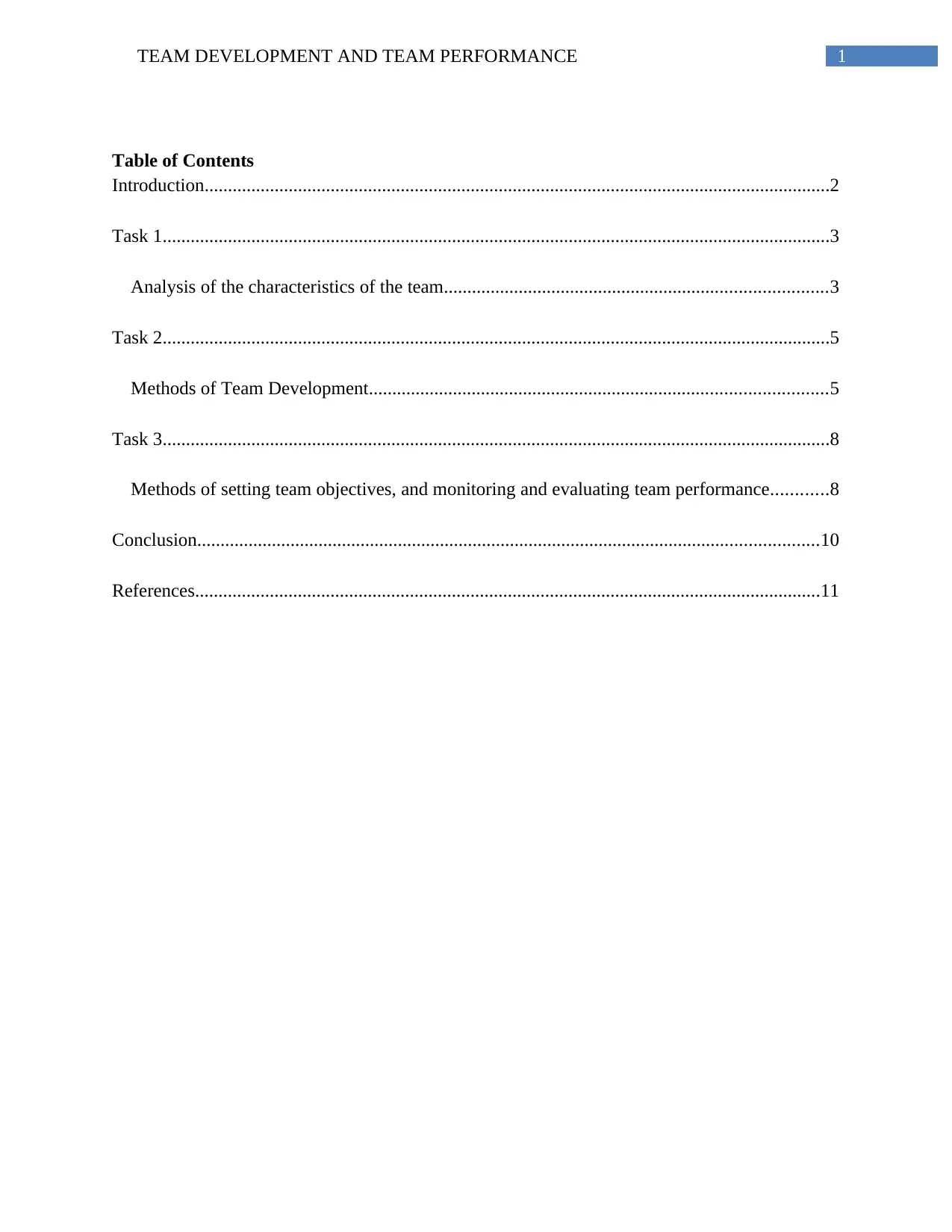
1TEAM DEVELOPMENT AND TEAM PERFORMANCE
Table of Contents
Introduction......................................................................................................................................2
Task 1...............................................................................................................................................3
Analysis of the characteristics of the team..................................................................................3
Task 2...............................................................................................................................................5
Methods of Team Development..................................................................................................5
Task 3...............................................................................................................................................8
Methods of setting team objectives, and monitoring and evaluating team performance............8
Conclusion.....................................................................................................................................10
References......................................................................................................................................11
Table of Contents
Introduction......................................................................................................................................2
Task 1...............................................................................................................................................3
Analysis of the characteristics of the team..................................................................................3
Task 2...............................................................................................................................................5
Methods of Team Development..................................................................................................5
Task 3...............................................................................................................................................8
Methods of setting team objectives, and monitoring and evaluating team performance............8
Conclusion.....................................................................................................................................10
References......................................................................................................................................11
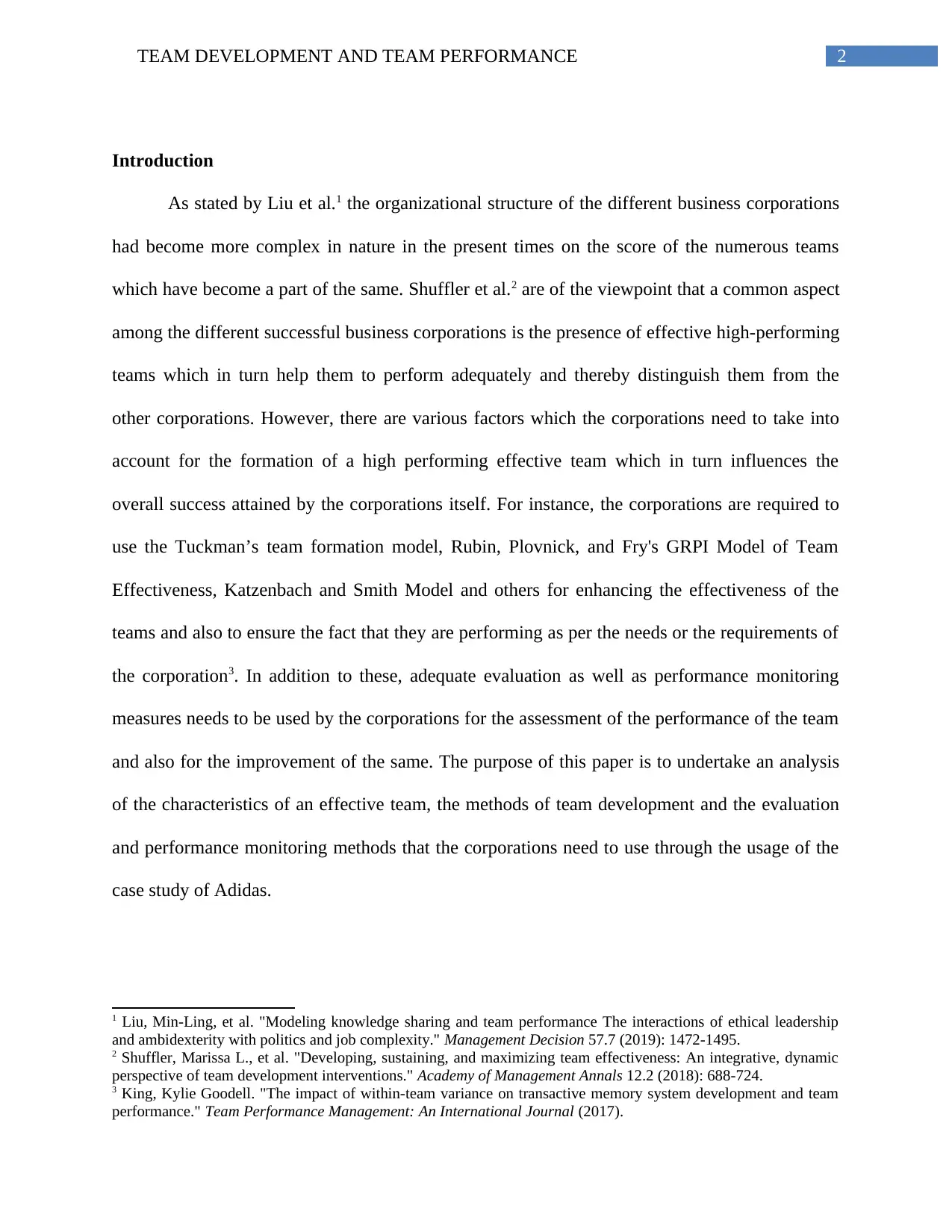
2TEAM DEVELOPMENT AND TEAM PERFORMANCE
Introduction
As stated by Liu et al.1 the organizational structure of the different business corporations
had become more complex in nature in the present times on the score of the numerous teams
which have become a part of the same. Shuffler et al.2 are of the viewpoint that a common aspect
among the different successful business corporations is the presence of effective high-performing
teams which in turn help them to perform adequately and thereby distinguish them from the
other corporations. However, there are various factors which the corporations need to take into
account for the formation of a high performing effective team which in turn influences the
overall success attained by the corporations itself. For instance, the corporations are required to
use the Tuckman’s team formation model, Rubin, Plovnick, and Fry's GRPI Model of Team
Effectiveness, Katzenbach and Smith Model and others for enhancing the effectiveness of the
teams and also to ensure the fact that they are performing as per the needs or the requirements of
the corporation3. In addition to these, adequate evaluation as well as performance monitoring
measures needs to be used by the corporations for the assessment of the performance of the team
and also for the improvement of the same. The purpose of this paper is to undertake an analysis
of the characteristics of an effective team, the methods of team development and the evaluation
and performance monitoring methods that the corporations need to use through the usage of the
case study of Adidas.
1 Liu, Min-Ling, et al. "Modeling knowledge sharing and team performance The interactions of ethical leadership
and ambidexterity with politics and job complexity." Management Decision 57.7 (2019): 1472-1495.
2 Shuffler, Marissa L., et al. "Developing, sustaining, and maximizing team effectiveness: An integrative, dynamic
perspective of team development interventions." Academy of Management Annals 12.2 (2018): 688-724.
3 King, Kylie Goodell. "The impact of within-team variance on transactive memory system development and team
performance." Team Performance Management: An International Journal (2017).
Introduction
As stated by Liu et al.1 the organizational structure of the different business corporations
had become more complex in nature in the present times on the score of the numerous teams
which have become a part of the same. Shuffler et al.2 are of the viewpoint that a common aspect
among the different successful business corporations is the presence of effective high-performing
teams which in turn help them to perform adequately and thereby distinguish them from the
other corporations. However, there are various factors which the corporations need to take into
account for the formation of a high performing effective team which in turn influences the
overall success attained by the corporations itself. For instance, the corporations are required to
use the Tuckman’s team formation model, Rubin, Plovnick, and Fry's GRPI Model of Team
Effectiveness, Katzenbach and Smith Model and others for enhancing the effectiveness of the
teams and also to ensure the fact that they are performing as per the needs or the requirements of
the corporation3. In addition to these, adequate evaluation as well as performance monitoring
measures needs to be used by the corporations for the assessment of the performance of the team
and also for the improvement of the same. The purpose of this paper is to undertake an analysis
of the characteristics of an effective team, the methods of team development and the evaluation
and performance monitoring methods that the corporations need to use through the usage of the
case study of Adidas.
1 Liu, Min-Ling, et al. "Modeling knowledge sharing and team performance The interactions of ethical leadership
and ambidexterity with politics and job complexity." Management Decision 57.7 (2019): 1472-1495.
2 Shuffler, Marissa L., et al. "Developing, sustaining, and maximizing team effectiveness: An integrative, dynamic
perspective of team development interventions." Academy of Management Annals 12.2 (2018): 688-724.
3 King, Kylie Goodell. "The impact of within-team variance on transactive memory system development and team
performance." Team Performance Management: An International Journal (2017).
⊘ This is a preview!⊘
Do you want full access?
Subscribe today to unlock all pages.

Trusted by 1+ million students worldwide
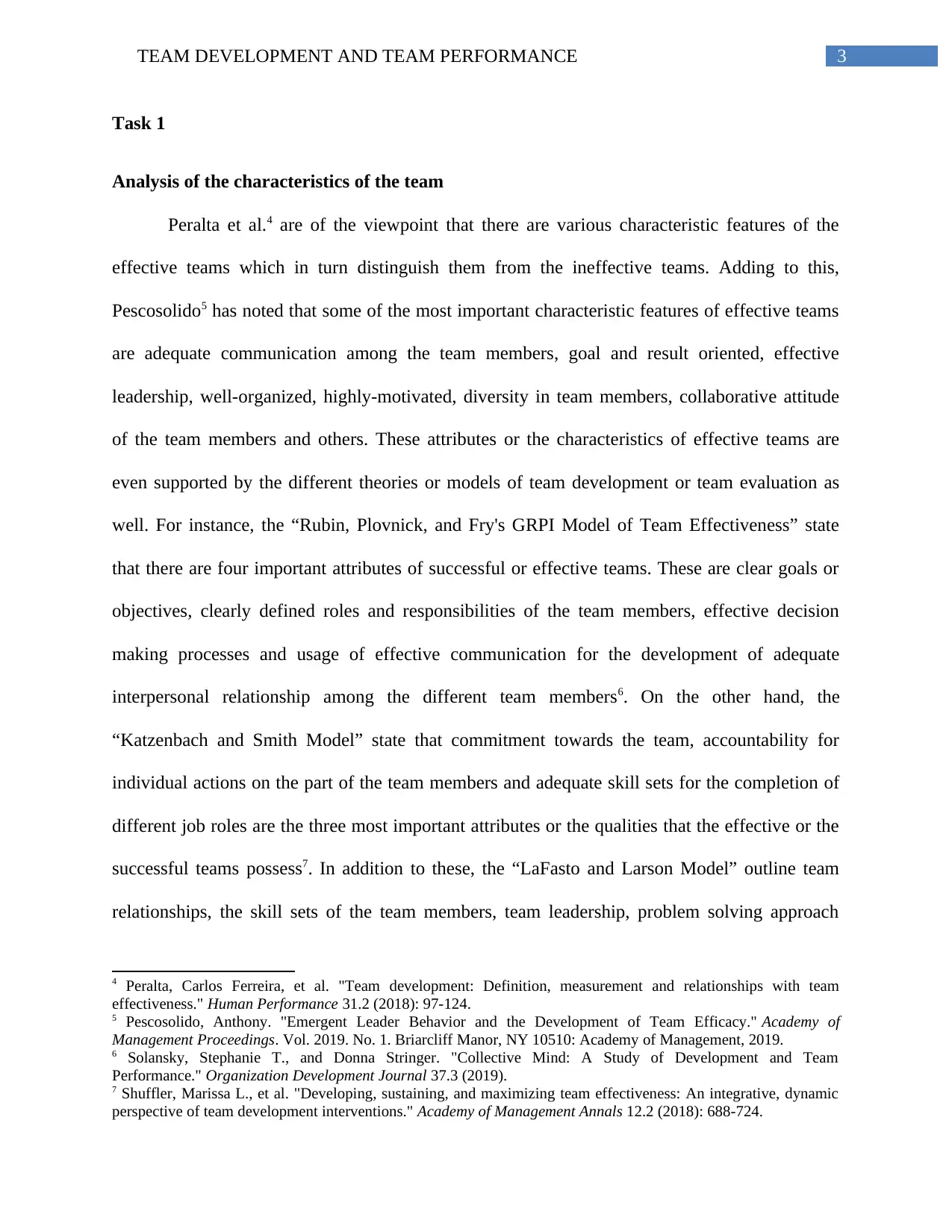
3TEAM DEVELOPMENT AND TEAM PERFORMANCE
Task 1
Analysis of the characteristics of the team
Peralta et al.4 are of the viewpoint that there are various characteristic features of the
effective teams which in turn distinguish them from the ineffective teams. Adding to this,
Pescosolido5 has noted that some of the most important characteristic features of effective teams
are adequate communication among the team members, goal and result oriented, effective
leadership, well-organized, highly-motivated, diversity in team members, collaborative attitude
of the team members and others. These attributes or the characteristics of effective teams are
even supported by the different theories or models of team development or team evaluation as
well. For instance, the “Rubin, Plovnick, and Fry's GRPI Model of Team Effectiveness” state
that there are four important attributes of successful or effective teams. These are clear goals or
objectives, clearly defined roles and responsibilities of the team members, effective decision
making processes and usage of effective communication for the development of adequate
interpersonal relationship among the different team members6. On the other hand, the
“Katzenbach and Smith Model” state that commitment towards the team, accountability for
individual actions on the part of the team members and adequate skill sets for the completion of
different job roles are the three most important attributes or the qualities that the effective or the
successful teams possess7. In addition to these, the “LaFasto and Larson Model” outline team
relationships, the skill sets of the team members, team leadership, problem solving approach
4 Peralta, Carlos Ferreira, et al. "Team development: Definition, measurement and relationships with team
effectiveness." Human Performance 31.2 (2018): 97-124.
5 Pescosolido, Anthony. "Emergent Leader Behavior and the Development of Team Efficacy." Academy of
Management Proceedings. Vol. 2019. No. 1. Briarcliff Manor, NY 10510: Academy of Management, 2019.
6 Solansky, Stephanie T., and Donna Stringer. "Collective Mind: A Study of Development and Team
Performance." Organization Development Journal 37.3 (2019).
7 Shuffler, Marissa L., et al. "Developing, sustaining, and maximizing team effectiveness: An integrative, dynamic
perspective of team development interventions." Academy of Management Annals 12.2 (2018): 688-724.
Task 1
Analysis of the characteristics of the team
Peralta et al.4 are of the viewpoint that there are various characteristic features of the
effective teams which in turn distinguish them from the ineffective teams. Adding to this,
Pescosolido5 has noted that some of the most important characteristic features of effective teams
are adequate communication among the team members, goal and result oriented, effective
leadership, well-organized, highly-motivated, diversity in team members, collaborative attitude
of the team members and others. These attributes or the characteristics of effective teams are
even supported by the different theories or models of team development or team evaluation as
well. For instance, the “Rubin, Plovnick, and Fry's GRPI Model of Team Effectiveness” state
that there are four important attributes of successful or effective teams. These are clear goals or
objectives, clearly defined roles and responsibilities of the team members, effective decision
making processes and usage of effective communication for the development of adequate
interpersonal relationship among the different team members6. On the other hand, the
“Katzenbach and Smith Model” state that commitment towards the team, accountability for
individual actions on the part of the team members and adequate skill sets for the completion of
different job roles are the three most important attributes or the qualities that the effective or the
successful teams possess7. In addition to these, the “LaFasto and Larson Model” outline team
relationships, the skill sets of the team members, team leadership, problem solving approach
4 Peralta, Carlos Ferreira, et al. "Team development: Definition, measurement and relationships with team
effectiveness." Human Performance 31.2 (2018): 97-124.
5 Pescosolido, Anthony. "Emergent Leader Behavior and the Development of Team Efficacy." Academy of
Management Proceedings. Vol. 2019. No. 1. Briarcliff Manor, NY 10510: Academy of Management, 2019.
6 Solansky, Stephanie T., and Donna Stringer. "Collective Mind: A Study of Development and Team
Performance." Organization Development Journal 37.3 (2019).
7 Shuffler, Marissa L., et al. "Developing, sustaining, and maximizing team effectiveness: An integrative, dynamic
perspective of team development interventions." Academy of Management Annals 12.2 (2018): 688-724.
Paraphrase This Document
Need a fresh take? Get an instant paraphrase of this document with our AI Paraphraser
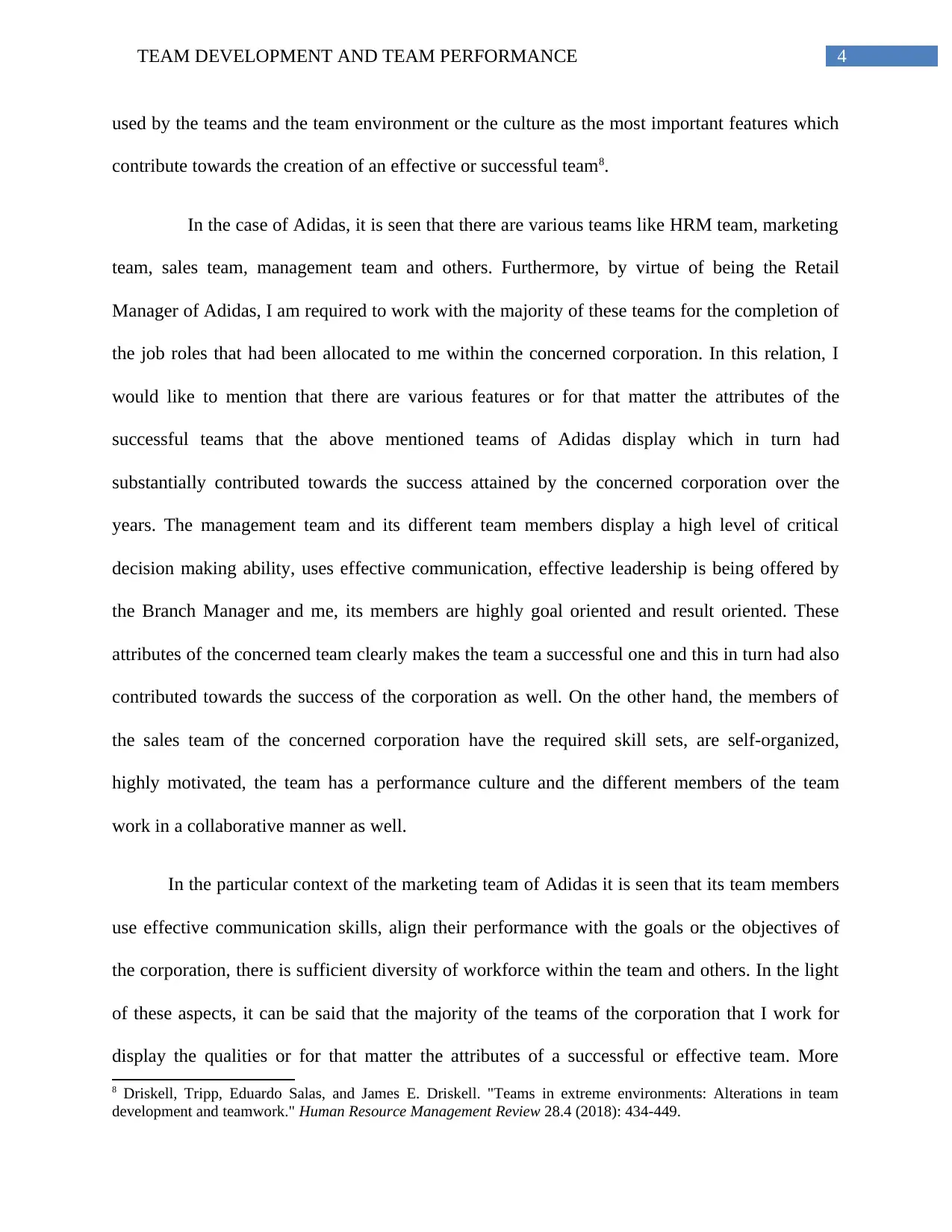
4TEAM DEVELOPMENT AND TEAM PERFORMANCE
used by the teams and the team environment or the culture as the most important features which
contribute towards the creation of an effective or successful team8.
In the case of Adidas, it is seen that there are various teams like HRM team, marketing
team, sales team, management team and others. Furthermore, by virtue of being the Retail
Manager of Adidas, I am required to work with the majority of these teams for the completion of
the job roles that had been allocated to me within the concerned corporation. In this relation, I
would like to mention that there are various features or for that matter the attributes of the
successful teams that the above mentioned teams of Adidas display which in turn had
substantially contributed towards the success attained by the concerned corporation over the
years. The management team and its different team members display a high level of critical
decision making ability, uses effective communication, effective leadership is being offered by
the Branch Manager and me, its members are highly goal oriented and result oriented. These
attributes of the concerned team clearly makes the team a successful one and this in turn had also
contributed towards the success of the corporation as well. On the other hand, the members of
the sales team of the concerned corporation have the required skill sets, are self-organized,
highly motivated, the team has a performance culture and the different members of the team
work in a collaborative manner as well.
In the particular context of the marketing team of Adidas it is seen that its team members
use effective communication skills, align their performance with the goals or the objectives of
the corporation, there is sufficient diversity of workforce within the team and others. In the light
of these aspects, it can be said that the majority of the teams of the corporation that I work for
display the qualities or for that matter the attributes of a successful or effective team. More
8 Driskell, Tripp, Eduardo Salas, and James E. Driskell. "Teams in extreme environments: Alterations in team
development and teamwork." Human Resource Management Review 28.4 (2018): 434-449.
used by the teams and the team environment or the culture as the most important features which
contribute towards the creation of an effective or successful team8.
In the case of Adidas, it is seen that there are various teams like HRM team, marketing
team, sales team, management team and others. Furthermore, by virtue of being the Retail
Manager of Adidas, I am required to work with the majority of these teams for the completion of
the job roles that had been allocated to me within the concerned corporation. In this relation, I
would like to mention that there are various features or for that matter the attributes of the
successful teams that the above mentioned teams of Adidas display which in turn had
substantially contributed towards the success attained by the concerned corporation over the
years. The management team and its different team members display a high level of critical
decision making ability, uses effective communication, effective leadership is being offered by
the Branch Manager and me, its members are highly goal oriented and result oriented. These
attributes of the concerned team clearly makes the team a successful one and this in turn had also
contributed towards the success of the corporation as well. On the other hand, the members of
the sales team of the concerned corporation have the required skill sets, are self-organized,
highly motivated, the team has a performance culture and the different members of the team
work in a collaborative manner as well.
In the particular context of the marketing team of Adidas it is seen that its team members
use effective communication skills, align their performance with the goals or the objectives of
the corporation, there is sufficient diversity of workforce within the team and others. In the light
of these aspects, it can be said that the majority of the teams of the corporation that I work for
display the qualities or for that matter the attributes of a successful or effective team. More
8 Driskell, Tripp, Eduardo Salas, and James E. Driskell. "Teams in extreme environments: Alterations in team
development and teamwork." Human Resource Management Review 28.4 (2018): 434-449.
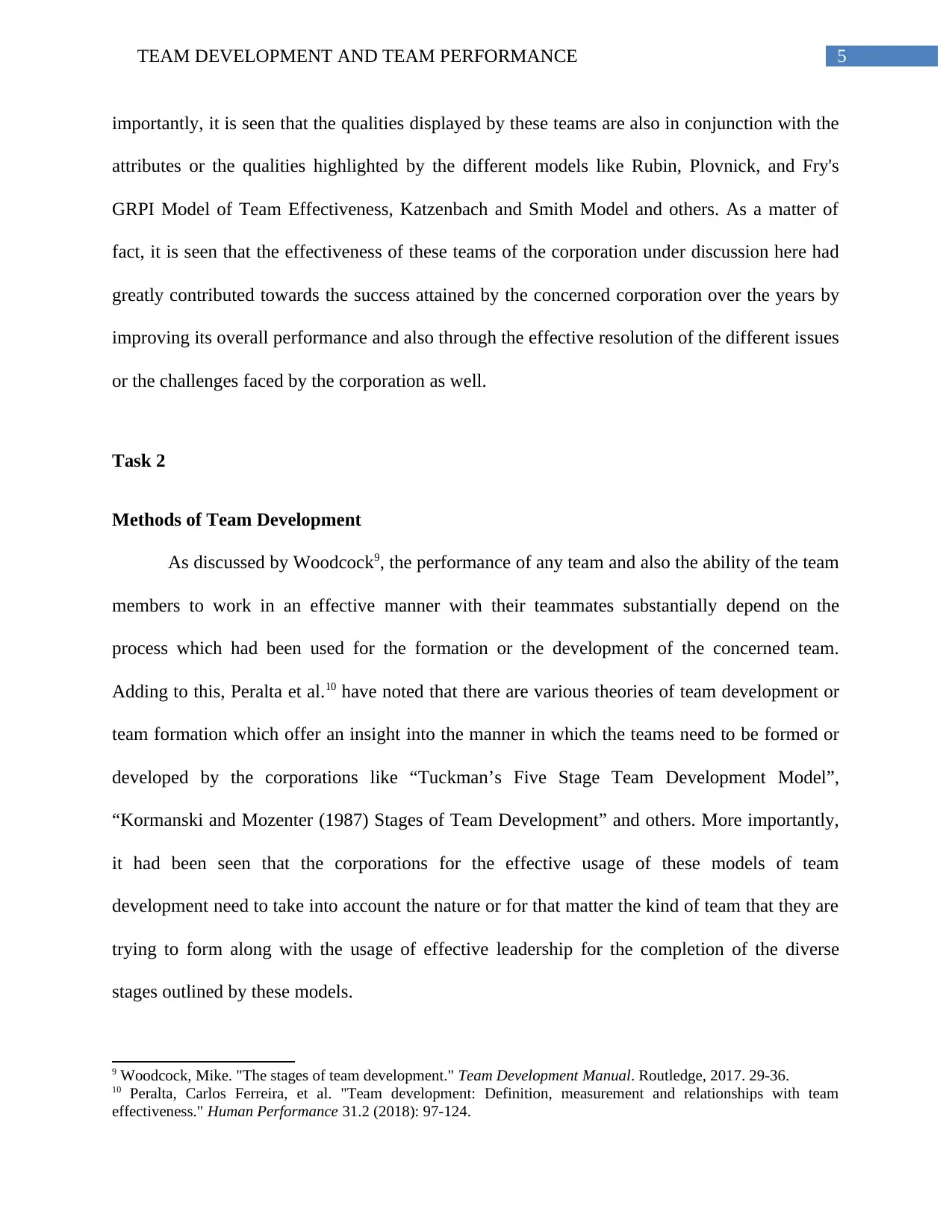
5TEAM DEVELOPMENT AND TEAM PERFORMANCE
importantly, it is seen that the qualities displayed by these teams are also in conjunction with the
attributes or the qualities highlighted by the different models like Rubin, Plovnick, and Fry's
GRPI Model of Team Effectiveness, Katzenbach and Smith Model and others. As a matter of
fact, it is seen that the effectiveness of these teams of the corporation under discussion here had
greatly contributed towards the success attained by the concerned corporation over the years by
improving its overall performance and also through the effective resolution of the different issues
or the challenges faced by the corporation as well.
Task 2
Methods of Team Development
As discussed by Woodcock9, the performance of any team and also the ability of the team
members to work in an effective manner with their teammates substantially depend on the
process which had been used for the formation or the development of the concerned team.
Adding to this, Peralta et al.10 have noted that there are various theories of team development or
team formation which offer an insight into the manner in which the teams need to be formed or
developed by the corporations like “Tuckman’s Five Stage Team Development Model”,
“Kormanski and Mozenter (1987) Stages of Team Development” and others. More importantly,
it had been seen that the corporations for the effective usage of these models of team
development need to take into account the nature or for that matter the kind of team that they are
trying to form along with the usage of effective leadership for the completion of the diverse
stages outlined by these models.
9 Woodcock, Mike. "The stages of team development." Team Development Manual. Routledge, 2017. 29-36.
10 Peralta, Carlos Ferreira, et al. "Team development: Definition, measurement and relationships with team
effectiveness." Human Performance 31.2 (2018): 97-124.
importantly, it is seen that the qualities displayed by these teams are also in conjunction with the
attributes or the qualities highlighted by the different models like Rubin, Plovnick, and Fry's
GRPI Model of Team Effectiveness, Katzenbach and Smith Model and others. As a matter of
fact, it is seen that the effectiveness of these teams of the corporation under discussion here had
greatly contributed towards the success attained by the concerned corporation over the years by
improving its overall performance and also through the effective resolution of the different issues
or the challenges faced by the corporation as well.
Task 2
Methods of Team Development
As discussed by Woodcock9, the performance of any team and also the ability of the team
members to work in an effective manner with their teammates substantially depend on the
process which had been used for the formation or the development of the concerned team.
Adding to this, Peralta et al.10 have noted that there are various theories of team development or
team formation which offer an insight into the manner in which the teams need to be formed or
developed by the corporations like “Tuckman’s Five Stage Team Development Model”,
“Kormanski and Mozenter (1987) Stages of Team Development” and others. More importantly,
it had been seen that the corporations for the effective usage of these models of team
development need to take into account the nature or for that matter the kind of team that they are
trying to form along with the usage of effective leadership for the completion of the diverse
stages outlined by these models.
9 Woodcock, Mike. "The stages of team development." Team Development Manual. Routledge, 2017. 29-36.
10 Peralta, Carlos Ferreira, et al. "Team development: Definition, measurement and relationships with team
effectiveness." Human Performance 31.2 (2018): 97-124.
⊘ This is a preview!⊘
Do you want full access?
Subscribe today to unlock all pages.

Trusted by 1+ million students worldwide
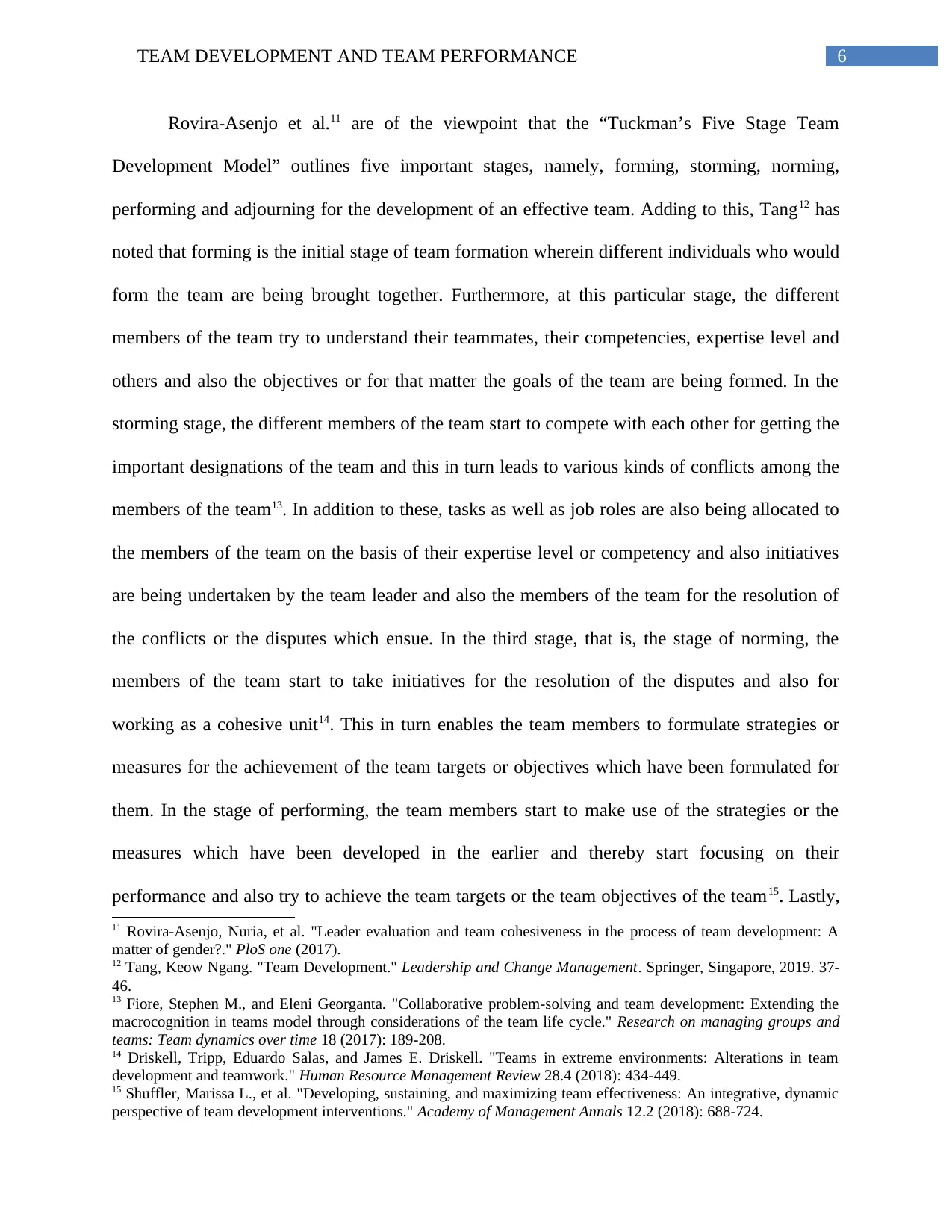
6TEAM DEVELOPMENT AND TEAM PERFORMANCE
Rovira-Asenjo et al.11 are of the viewpoint that the “Tuckman’s Five Stage Team
Development Model” outlines five important stages, namely, forming, storming, norming,
performing and adjourning for the development of an effective team. Adding to this, Tang12 has
noted that forming is the initial stage of team formation wherein different individuals who would
form the team are being brought together. Furthermore, at this particular stage, the different
members of the team try to understand their teammates, their competencies, expertise level and
others and also the objectives or for that matter the goals of the team are being formed. In the
storming stage, the different members of the team start to compete with each other for getting the
important designations of the team and this in turn leads to various kinds of conflicts among the
members of the team13. In addition to these, tasks as well as job roles are also being allocated to
the members of the team on the basis of their expertise level or competency and also initiatives
are being undertaken by the team leader and also the members of the team for the resolution of
the conflicts or the disputes which ensue. In the third stage, that is, the stage of norming, the
members of the team start to take initiatives for the resolution of the disputes and also for
working as a cohesive unit14. This in turn enables the team members to formulate strategies or
measures for the achievement of the team targets or objectives which have been formulated for
them. In the stage of performing, the team members start to make use of the strategies or the
measures which have been developed in the earlier and thereby start focusing on their
performance and also try to achieve the team targets or the team objectives of the team15. Lastly,
11 Rovira-Asenjo, Nuria, et al. "Leader evaluation and team cohesiveness in the process of team development: A
matter of gender?." PloS one (2017).
12 Tang, Keow Ngang. "Team Development." Leadership and Change Management. Springer, Singapore, 2019. 37-
46.
13 Fiore, Stephen M., and Eleni Georganta. "Collaborative problem-solving and team development: Extending the
macrocognition in teams model through considerations of the team life cycle." Research on managing groups and
teams: Team dynamics over time 18 (2017): 189-208.
14 Driskell, Tripp, Eduardo Salas, and James E. Driskell. "Teams in extreme environments: Alterations in team
development and teamwork." Human Resource Management Review 28.4 (2018): 434-449.
15 Shuffler, Marissa L., et al. "Developing, sustaining, and maximizing team effectiveness: An integrative, dynamic
perspective of team development interventions." Academy of Management Annals 12.2 (2018): 688-724.
Rovira-Asenjo et al.11 are of the viewpoint that the “Tuckman’s Five Stage Team
Development Model” outlines five important stages, namely, forming, storming, norming,
performing and adjourning for the development of an effective team. Adding to this, Tang12 has
noted that forming is the initial stage of team formation wherein different individuals who would
form the team are being brought together. Furthermore, at this particular stage, the different
members of the team try to understand their teammates, their competencies, expertise level and
others and also the objectives or for that matter the goals of the team are being formed. In the
storming stage, the different members of the team start to compete with each other for getting the
important designations of the team and this in turn leads to various kinds of conflicts among the
members of the team13. In addition to these, tasks as well as job roles are also being allocated to
the members of the team on the basis of their expertise level or competency and also initiatives
are being undertaken by the team leader and also the members of the team for the resolution of
the conflicts or the disputes which ensue. In the third stage, that is, the stage of norming, the
members of the team start to take initiatives for the resolution of the disputes and also for
working as a cohesive unit14. This in turn enables the team members to formulate strategies or
measures for the achievement of the team targets or objectives which have been formulated for
them. In the stage of performing, the team members start to make use of the strategies or the
measures which have been developed in the earlier and thereby start focusing on their
performance and also try to achieve the team targets or the team objectives of the team15. Lastly,
11 Rovira-Asenjo, Nuria, et al. "Leader evaluation and team cohesiveness in the process of team development: A
matter of gender?." PloS one (2017).
12 Tang, Keow Ngang. "Team Development." Leadership and Change Management. Springer, Singapore, 2019. 37-
46.
13 Fiore, Stephen M., and Eleni Georganta. "Collaborative problem-solving and team development: Extending the
macrocognition in teams model through considerations of the team life cycle." Research on managing groups and
teams: Team dynamics over time 18 (2017): 189-208.
14 Driskell, Tripp, Eduardo Salas, and James E. Driskell. "Teams in extreme environments: Alterations in team
development and teamwork." Human Resource Management Review 28.4 (2018): 434-449.
15 Shuffler, Marissa L., et al. "Developing, sustaining, and maximizing team effectiveness: An integrative, dynamic
perspective of team development interventions." Academy of Management Annals 12.2 (2018): 688-724.
Paraphrase This Document
Need a fresh take? Get an instant paraphrase of this document with our AI Paraphraser
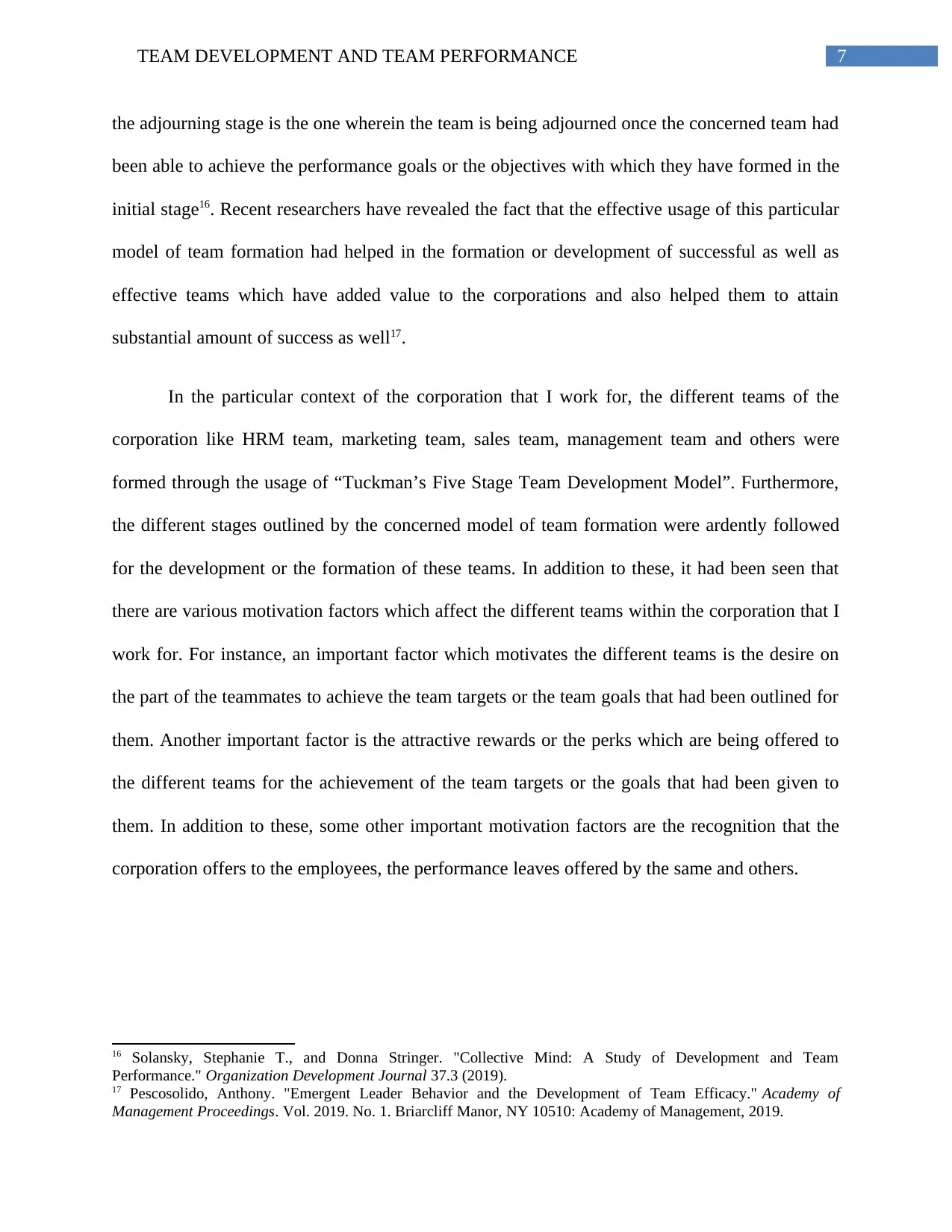
7TEAM DEVELOPMENT AND TEAM PERFORMANCE
the adjourning stage is the one wherein the team is being adjourned once the concerned team had
been able to achieve the performance goals or the objectives with which they have formed in the
initial stage16. Recent researchers have revealed the fact that the effective usage of this particular
model of team formation had helped in the formation or development of successful as well as
effective teams which have added value to the corporations and also helped them to attain
substantial amount of success as well17.
In the particular context of the corporation that I work for, the different teams of the
corporation like HRM team, marketing team, sales team, management team and others were
formed through the usage of “Tuckman’s Five Stage Team Development Model”. Furthermore,
the different stages outlined by the concerned model of team formation were ardently followed
for the development or the formation of these teams. In addition to these, it had been seen that
there are various motivation factors which affect the different teams within the corporation that I
work for. For instance, an important factor which motivates the different teams is the desire on
the part of the teammates to achieve the team targets or the team goals that had been outlined for
them. Another important factor is the attractive rewards or the perks which are being offered to
the different teams for the achievement of the team targets or the goals that had been given to
them. In addition to these, some other important motivation factors are the recognition that the
corporation offers to the employees, the performance leaves offered by the same and others.
16 Solansky, Stephanie T., and Donna Stringer. "Collective Mind: A Study of Development and Team
Performance." Organization Development Journal 37.3 (2019).
17 Pescosolido, Anthony. "Emergent Leader Behavior and the Development of Team Efficacy." Academy of
Management Proceedings. Vol. 2019. No. 1. Briarcliff Manor, NY 10510: Academy of Management, 2019.
the adjourning stage is the one wherein the team is being adjourned once the concerned team had
been able to achieve the performance goals or the objectives with which they have formed in the
initial stage16. Recent researchers have revealed the fact that the effective usage of this particular
model of team formation had helped in the formation or development of successful as well as
effective teams which have added value to the corporations and also helped them to attain
substantial amount of success as well17.
In the particular context of the corporation that I work for, the different teams of the
corporation like HRM team, marketing team, sales team, management team and others were
formed through the usage of “Tuckman’s Five Stage Team Development Model”. Furthermore,
the different stages outlined by the concerned model of team formation were ardently followed
for the development or the formation of these teams. In addition to these, it had been seen that
there are various motivation factors which affect the different teams within the corporation that I
work for. For instance, an important factor which motivates the different teams is the desire on
the part of the teammates to achieve the team targets or the team goals that had been outlined for
them. Another important factor is the attractive rewards or the perks which are being offered to
the different teams for the achievement of the team targets or the goals that had been given to
them. In addition to these, some other important motivation factors are the recognition that the
corporation offers to the employees, the performance leaves offered by the same and others.
16 Solansky, Stephanie T., and Donna Stringer. "Collective Mind: A Study of Development and Team
Performance." Organization Development Journal 37.3 (2019).
17 Pescosolido, Anthony. "Emergent Leader Behavior and the Development of Team Efficacy." Academy of
Management Proceedings. Vol. 2019. No. 1. Briarcliff Manor, NY 10510: Academy of Management, 2019.
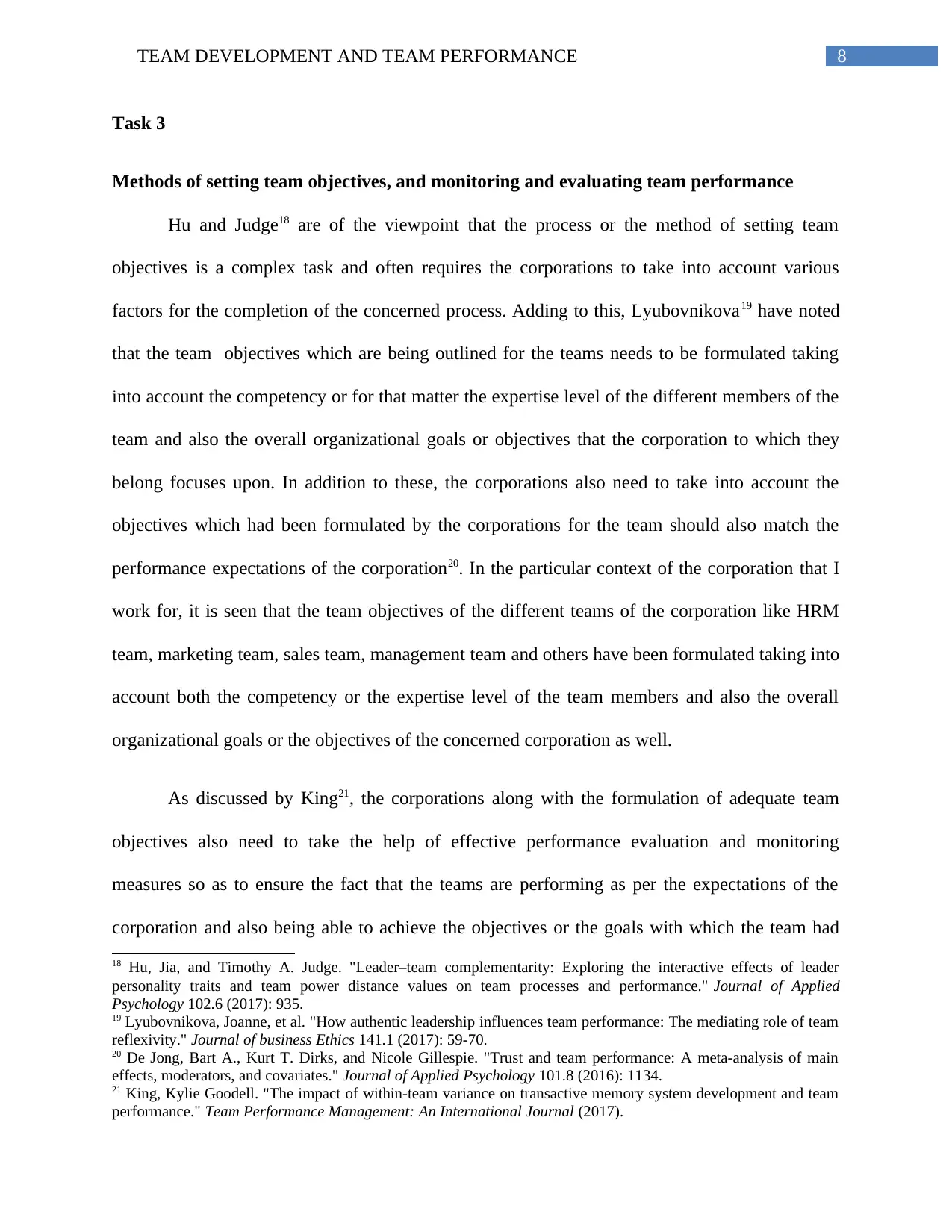
8TEAM DEVELOPMENT AND TEAM PERFORMANCE
Task 3
Methods of setting team objectives, and monitoring and evaluating team performance
Hu and Judge18 are of the viewpoint that the process or the method of setting team
objectives is a complex task and often requires the corporations to take into account various
factors for the completion of the concerned process. Adding to this, Lyubovnikova19 have noted
that the team objectives which are being outlined for the teams needs to be formulated taking
into account the competency or for that matter the expertise level of the different members of the
team and also the overall organizational goals or objectives that the corporation to which they
belong focuses upon. In addition to these, the corporations also need to take into account the
objectives which had been formulated by the corporations for the team should also match the
performance expectations of the corporation20. In the particular context of the corporation that I
work for, it is seen that the team objectives of the different teams of the corporation like HRM
team, marketing team, sales team, management team and others have been formulated taking into
account both the competency or the expertise level of the team members and also the overall
organizational goals or the objectives of the concerned corporation as well.
As discussed by King21, the corporations along with the formulation of adequate team
objectives also need to take the help of effective performance evaluation and monitoring
measures so as to ensure the fact that the teams are performing as per the expectations of the
corporation and also being able to achieve the objectives or the goals with which the team had
18 Hu, Jia, and Timothy A. Judge. "Leader–team complementarity: Exploring the interactive effects of leader
personality traits and team power distance values on team processes and performance." Journal of Applied
Psychology 102.6 (2017): 935.
19 Lyubovnikova, Joanne, et al. "How authentic leadership influences team performance: The mediating role of team
reflexivity." Journal of business Ethics 141.1 (2017): 59-70.
20 De Jong, Bart A., Kurt T. Dirks, and Nicole Gillespie. "Trust and team performance: A meta-analysis of main
effects, moderators, and covariates." Journal of Applied Psychology 101.8 (2016): 1134.
21 King, Kylie Goodell. "The impact of within-team variance on transactive memory system development and team
performance." Team Performance Management: An International Journal (2017).
Task 3
Methods of setting team objectives, and monitoring and evaluating team performance
Hu and Judge18 are of the viewpoint that the process or the method of setting team
objectives is a complex task and often requires the corporations to take into account various
factors for the completion of the concerned process. Adding to this, Lyubovnikova19 have noted
that the team objectives which are being outlined for the teams needs to be formulated taking
into account the competency or for that matter the expertise level of the different members of the
team and also the overall organizational goals or objectives that the corporation to which they
belong focuses upon. In addition to these, the corporations also need to take into account the
objectives which had been formulated by the corporations for the team should also match the
performance expectations of the corporation20. In the particular context of the corporation that I
work for, it is seen that the team objectives of the different teams of the corporation like HRM
team, marketing team, sales team, management team and others have been formulated taking into
account both the competency or the expertise level of the team members and also the overall
organizational goals or the objectives of the concerned corporation as well.
As discussed by King21, the corporations along with the formulation of adequate team
objectives also need to take the help of effective performance evaluation and monitoring
measures so as to ensure the fact that the teams are performing as per the expectations of the
corporation and also being able to achieve the objectives or the goals with which the team had
18 Hu, Jia, and Timothy A. Judge. "Leader–team complementarity: Exploring the interactive effects of leader
personality traits and team power distance values on team processes and performance." Journal of Applied
Psychology 102.6 (2017): 935.
19 Lyubovnikova, Joanne, et al. "How authentic leadership influences team performance: The mediating role of team
reflexivity." Journal of business Ethics 141.1 (2017): 59-70.
20 De Jong, Bart A., Kurt T. Dirks, and Nicole Gillespie. "Trust and team performance: A meta-analysis of main
effects, moderators, and covariates." Journal of Applied Psychology 101.8 (2016): 1134.
21 King, Kylie Goodell. "The impact of within-team variance on transactive memory system development and team
performance." Team Performance Management: An International Journal (2017).
⊘ This is a preview!⊘
Do you want full access?
Subscribe today to unlock all pages.

Trusted by 1+ million students worldwide
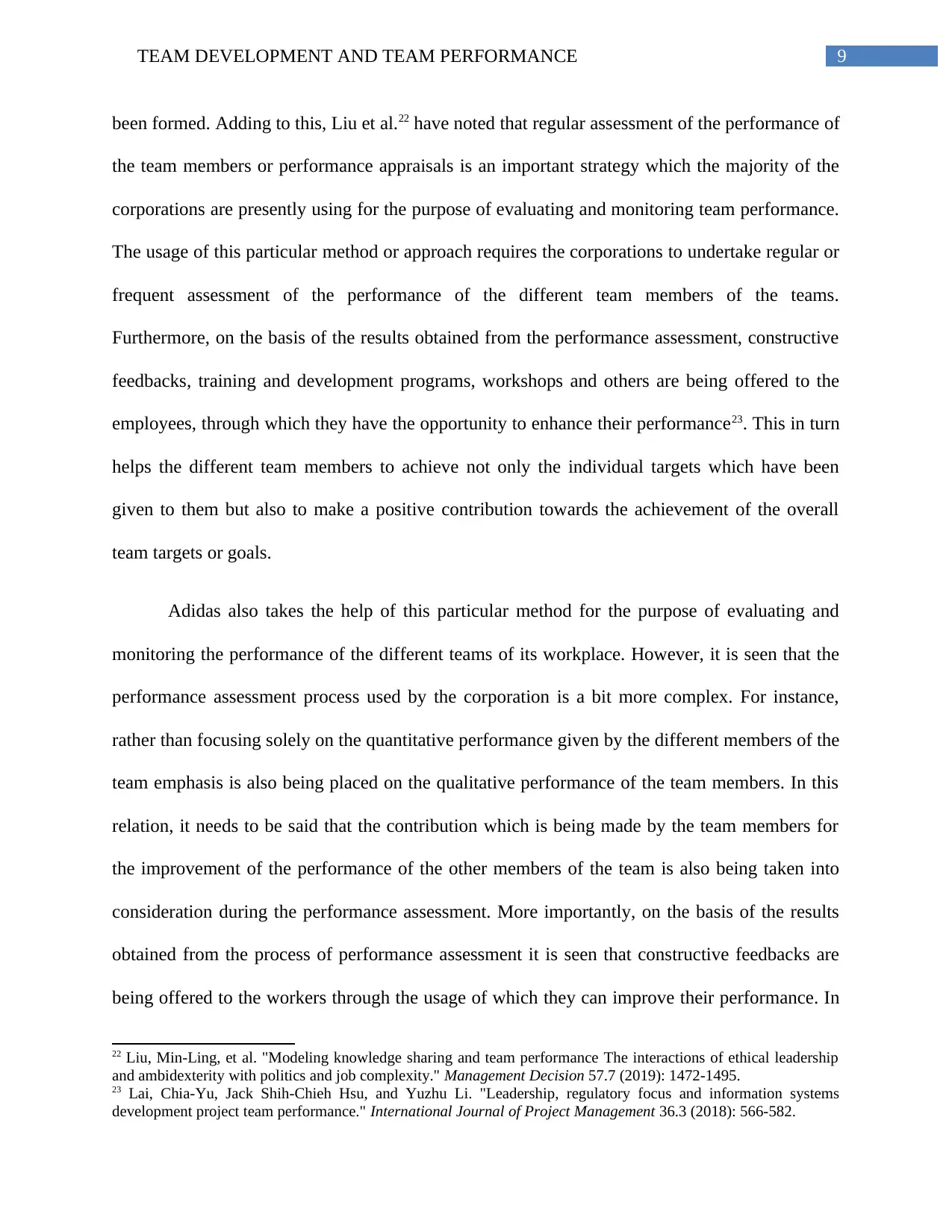
9TEAM DEVELOPMENT AND TEAM PERFORMANCE
been formed. Adding to this, Liu et al.22 have noted that regular assessment of the performance of
the team members or performance appraisals is an important strategy which the majority of the
corporations are presently using for the purpose of evaluating and monitoring team performance.
The usage of this particular method or approach requires the corporations to undertake regular or
frequent assessment of the performance of the different team members of the teams.
Furthermore, on the basis of the results obtained from the performance assessment, constructive
feedbacks, training and development programs, workshops and others are being offered to the
employees, through which they have the opportunity to enhance their performance23. This in turn
helps the different team members to achieve not only the individual targets which have been
given to them but also to make a positive contribution towards the achievement of the overall
team targets or goals.
Adidas also takes the help of this particular method for the purpose of evaluating and
monitoring the performance of the different teams of its workplace. However, it is seen that the
performance assessment process used by the corporation is a bit more complex. For instance,
rather than focusing solely on the quantitative performance given by the different members of the
team emphasis is also being placed on the qualitative performance of the team members. In this
relation, it needs to be said that the contribution which is being made by the team members for
the improvement of the performance of the other members of the team is also being taken into
consideration during the performance assessment. More importantly, on the basis of the results
obtained from the process of performance assessment it is seen that constructive feedbacks are
being offered to the workers through the usage of which they can improve their performance. In
22 Liu, Min-Ling, et al. "Modeling knowledge sharing and team performance The interactions of ethical leadership
and ambidexterity with politics and job complexity." Management Decision 57.7 (2019): 1472-1495.
23 Lai, Chia-Yu, Jack Shih-Chieh Hsu, and Yuzhu Li. "Leadership, regulatory focus and information systems
development project team performance." International Journal of Project Management 36.3 (2018): 566-582.
been formed. Adding to this, Liu et al.22 have noted that regular assessment of the performance of
the team members or performance appraisals is an important strategy which the majority of the
corporations are presently using for the purpose of evaluating and monitoring team performance.
The usage of this particular method or approach requires the corporations to undertake regular or
frequent assessment of the performance of the different team members of the teams.
Furthermore, on the basis of the results obtained from the performance assessment, constructive
feedbacks, training and development programs, workshops and others are being offered to the
employees, through which they have the opportunity to enhance their performance23. This in turn
helps the different team members to achieve not only the individual targets which have been
given to them but also to make a positive contribution towards the achievement of the overall
team targets or goals.
Adidas also takes the help of this particular method for the purpose of evaluating and
monitoring the performance of the different teams of its workplace. However, it is seen that the
performance assessment process used by the corporation is a bit more complex. For instance,
rather than focusing solely on the quantitative performance given by the different members of the
team emphasis is also being placed on the qualitative performance of the team members. In this
relation, it needs to be said that the contribution which is being made by the team members for
the improvement of the performance of the other members of the team is also being taken into
consideration during the performance assessment. More importantly, on the basis of the results
obtained from the process of performance assessment it is seen that constructive feedbacks are
being offered to the workers through the usage of which they can improve their performance. In
22 Liu, Min-Ling, et al. "Modeling knowledge sharing and team performance The interactions of ethical leadership
and ambidexterity with politics and job complexity." Management Decision 57.7 (2019): 1472-1495.
23 Lai, Chia-Yu, Jack Shih-Chieh Hsu, and Yuzhu Li. "Leadership, regulatory focus and information systems
development project team performance." International Journal of Project Management 36.3 (2018): 566-582.
Paraphrase This Document
Need a fresh take? Get an instant paraphrase of this document with our AI Paraphraser
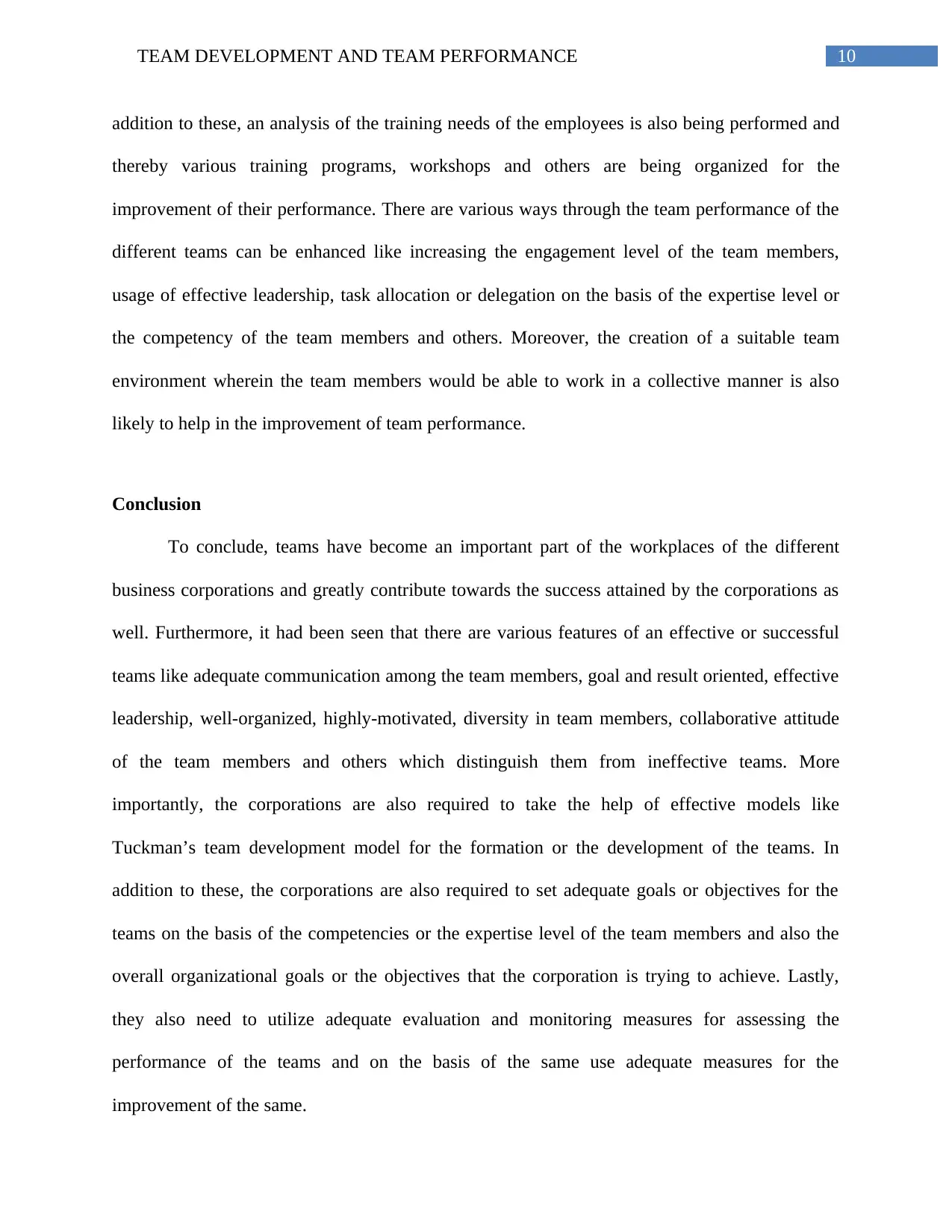
10TEAM DEVELOPMENT AND TEAM PERFORMANCE
addition to these, an analysis of the training needs of the employees is also being performed and
thereby various training programs, workshops and others are being organized for the
improvement of their performance. There are various ways through the team performance of the
different teams can be enhanced like increasing the engagement level of the team members,
usage of effective leadership, task allocation or delegation on the basis of the expertise level or
the competency of the team members and others. Moreover, the creation of a suitable team
environment wherein the team members would be able to work in a collective manner is also
likely to help in the improvement of team performance.
Conclusion
To conclude, teams have become an important part of the workplaces of the different
business corporations and greatly contribute towards the success attained by the corporations as
well. Furthermore, it had been seen that there are various features of an effective or successful
teams like adequate communication among the team members, goal and result oriented, effective
leadership, well-organized, highly-motivated, diversity in team members, collaborative attitude
of the team members and others which distinguish them from ineffective teams. More
importantly, the corporations are also required to take the help of effective models like
Tuckman’s team development model for the formation or the development of the teams. In
addition to these, the corporations are also required to set adequate goals or objectives for the
teams on the basis of the competencies or the expertise level of the team members and also the
overall organizational goals or the objectives that the corporation is trying to achieve. Lastly,
they also need to utilize adequate evaluation and monitoring measures for assessing the
performance of the teams and on the basis of the same use adequate measures for the
improvement of the same.
addition to these, an analysis of the training needs of the employees is also being performed and
thereby various training programs, workshops and others are being organized for the
improvement of their performance. There are various ways through the team performance of the
different teams can be enhanced like increasing the engagement level of the team members,
usage of effective leadership, task allocation or delegation on the basis of the expertise level or
the competency of the team members and others. Moreover, the creation of a suitable team
environment wherein the team members would be able to work in a collective manner is also
likely to help in the improvement of team performance.
Conclusion
To conclude, teams have become an important part of the workplaces of the different
business corporations and greatly contribute towards the success attained by the corporations as
well. Furthermore, it had been seen that there are various features of an effective or successful
teams like adequate communication among the team members, goal and result oriented, effective
leadership, well-organized, highly-motivated, diversity in team members, collaborative attitude
of the team members and others which distinguish them from ineffective teams. More
importantly, the corporations are also required to take the help of effective models like
Tuckman’s team development model for the formation or the development of the teams. In
addition to these, the corporations are also required to set adequate goals or objectives for the
teams on the basis of the competencies or the expertise level of the team members and also the
overall organizational goals or the objectives that the corporation is trying to achieve. Lastly,
they also need to utilize adequate evaluation and monitoring measures for assessing the
performance of the teams and on the basis of the same use adequate measures for the
improvement of the same.
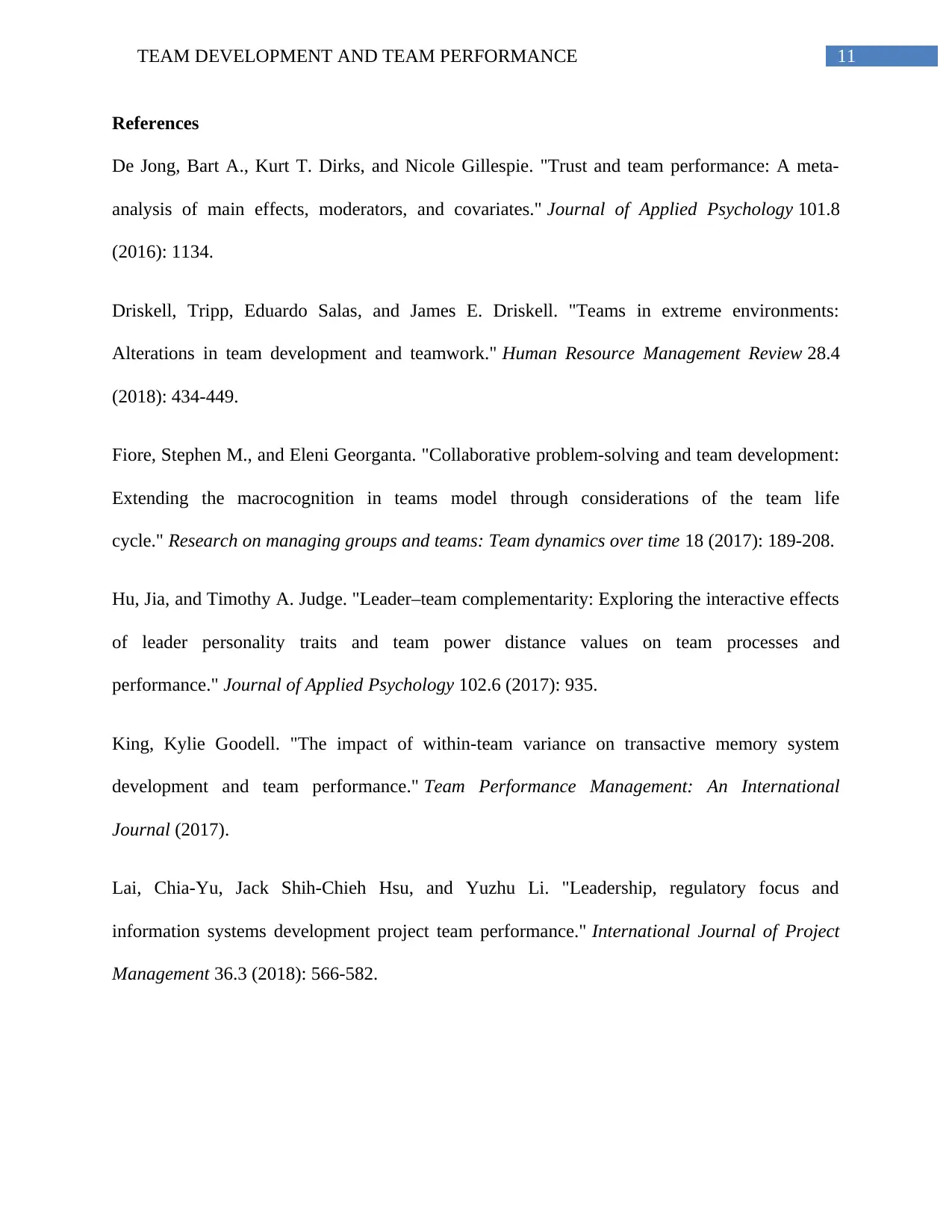
11TEAM DEVELOPMENT AND TEAM PERFORMANCE
References
De Jong, Bart A., Kurt T. Dirks, and Nicole Gillespie. "Trust and team performance: A meta-
analysis of main effects, moderators, and covariates." Journal of Applied Psychology 101.8
(2016): 1134.
Driskell, Tripp, Eduardo Salas, and James E. Driskell. "Teams in extreme environments:
Alterations in team development and teamwork." Human Resource Management Review 28.4
(2018): 434-449.
Fiore, Stephen M., and Eleni Georganta. "Collaborative problem-solving and team development:
Extending the macrocognition in teams model through considerations of the team life
cycle." Research on managing groups and teams: Team dynamics over time 18 (2017): 189-208.
Hu, Jia, and Timothy A. Judge. "Leader–team complementarity: Exploring the interactive effects
of leader personality traits and team power distance values on team processes and
performance." Journal of Applied Psychology 102.6 (2017): 935.
King, Kylie Goodell. "The impact of within-team variance on transactive memory system
development and team performance." Team Performance Management: An International
Journal (2017).
Lai, Chia-Yu, Jack Shih-Chieh Hsu, and Yuzhu Li. "Leadership, regulatory focus and
information systems development project team performance." International Journal of Project
Management 36.3 (2018): 566-582.
References
De Jong, Bart A., Kurt T. Dirks, and Nicole Gillespie. "Trust and team performance: A meta-
analysis of main effects, moderators, and covariates." Journal of Applied Psychology 101.8
(2016): 1134.
Driskell, Tripp, Eduardo Salas, and James E. Driskell. "Teams in extreme environments:
Alterations in team development and teamwork." Human Resource Management Review 28.4
(2018): 434-449.
Fiore, Stephen M., and Eleni Georganta. "Collaborative problem-solving and team development:
Extending the macrocognition in teams model through considerations of the team life
cycle." Research on managing groups and teams: Team dynamics over time 18 (2017): 189-208.
Hu, Jia, and Timothy A. Judge. "Leader–team complementarity: Exploring the interactive effects
of leader personality traits and team power distance values on team processes and
performance." Journal of Applied Psychology 102.6 (2017): 935.
King, Kylie Goodell. "The impact of within-team variance on transactive memory system
development and team performance." Team Performance Management: An International
Journal (2017).
Lai, Chia-Yu, Jack Shih-Chieh Hsu, and Yuzhu Li. "Leadership, regulatory focus and
information systems development project team performance." International Journal of Project
Management 36.3 (2018): 566-582.
⊘ This is a preview!⊘
Do you want full access?
Subscribe today to unlock all pages.

Trusted by 1+ million students worldwide
1 out of 14
Related Documents
Your All-in-One AI-Powered Toolkit for Academic Success.
+13062052269
info@desklib.com
Available 24*7 on WhatsApp / Email
![[object Object]](/_next/static/media/star-bottom.7253800d.svg)
Unlock your academic potential
Copyright © 2020–2025 A2Z Services. All Rights Reserved. Developed and managed by ZUCOL.




